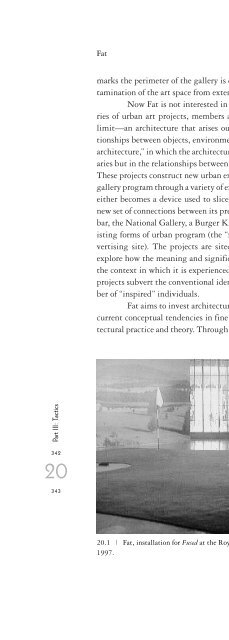The Unknown City: Contesting Architecture and Social Space
The Unknown City: Contesting Architecture and Social Space The Unknown City: Contesting Architecture and Social Space
Part III: Tactics 342 20 343 Fat marks the perimeter of the gallery is erased, the seal that prevents the contamination of the art space from external influence is broken. Now Fat is not interested in destroying the gallery. Through a series of urban art projects, members are proposing architecture at its very limit—an architecture that arises out of provisional and negotiated relationships between objects, environments, and programs. It is an “extended architecture,” in which the architecture resides not in the making of boundaries but in the relationships between event (function) and territory (space). These projects construct new urban experiences by the redistribution of the gallery program through a variety of existing urban situations. The program either becomes a device used to slice through the city (Outpost), making a new set of connections between its previously unconnected parts (the go-go bar, the National Gallery, a Burger King), or is parasitically attached to existing forms of urban program (the “for sale” sign, the bus shelter, the advertising site). The projects are sited outside the gallery so that we can explore how the meaning and significance of a work of art are read against the context in which it is experienced. A number of artists involved in the projects subvert the conventional identification of “artists” as a small number of “inspired” individuals. Fat aims to invest architecture with a critical agenda that draws on current conceptual tendencies in fine art as well as on contemporary architectural practice and theory. Through a critical analysis of architectural rep- 20.1 | Fat, installation for Fused at the Royal Institute of British Architects, London, 1997.
- Page 690: 18.2 | Mark Prizeman, The Chemical
- Page 694: Brief Encounters imaging of spaces
- Page 698: Brief Encounters mass and substance
- Page 702: Brief Encounters place was attracti
- Page 706: 18.8 | “Gamma Tokyo” design for
- Page 710: Note This text is an edited version
- Page 714: Urban art projects can embody a cri
- Page 718: Live Adventures manifest themselves
- Page 722: 19.4 | Park in the Park: installati
- Page 726: Live Adventures as a main point of
- Page 730: the “well-serviced shed.” (Coin
- Page 734: Notes This chapter is based on a pr
- Page 738: Fat’s architecture is generated v
- Page 744: Part III: Tactics 344 20 345 Fat 20
- Page 748: Part III: Tactics 346 20 347 20.5 2
- Page 752: Part III: Tactics 348 20 349 Fat 20
- Page 756: Part III: Tactics 350 20 351 Fat PA
- Page 760: Part III: Tactics 352 20 353 Fat BL
- Page 764: Part III: Tactics 354 20 355 20.12
- Page 768: Dolores Hayden 21 Claiming Women’
- Page 772: Part III: Tactics 358 21 359 Dolore
- Page 776: Part III: Tactics 360 21 361 Dolore
- Page 780: Part III: Tactics 362 21 363 Dolore
- Page 784: Part III: Tactics 364 21 365 Dolore
- Page 788: Part III: Tactics 366 21 367 Dolore
Part III: Tactics<br />
342<br />
20<br />
343<br />
Fat<br />
marks the perimeter of the gallery is erased, the seal that prevents the contamination<br />
of the art space from external influence is broken.<br />
Now Fat is not interested in destroying the gallery. Through a series<br />
of urban art projects, members are proposing architecture at its very<br />
limit—an architecture that arises out of provisional <strong>and</strong> negotiated relationships<br />
between objects, environments, <strong>and</strong> programs. It is an “extended<br />
architecture,” in which the architecture resides not in the making of boundaries<br />
but in the relationships between event (function) <strong>and</strong> territory (space).<br />
<strong>The</strong>se projects construct new urban experiences by the redistribution of the<br />
gallery program through a variety of existing urban situations. <strong>The</strong> program<br />
either becomes a device used to slice through the city (Outpost), making a<br />
new set of connections between its previously unconnected parts (the go-go<br />
bar, the National Gallery, a Burger King), or is parasitically attached to existing<br />
forms of urban program (the “for sale” sign, the bus shelter, the advertising<br />
site). <strong>The</strong> projects are sited outside the gallery so that we can<br />
explore how the meaning <strong>and</strong> significance of a work of art are read against<br />
the context in which it is experienced. A number of artists involved in the<br />
projects subvert the conventional identification of “artists” as a small number<br />
of “inspired” individuals.<br />
Fat aims to invest architecture with a critical agenda that draws on<br />
current conceptual tendencies in fine art as well as on contemporary architectural<br />
practice <strong>and</strong> theory. Through a critical analysis of architectural rep-<br />
20.1 | Fat, installation for Fused at the Royal Institute of British Architects, London,<br />
1997.



